Our first LED flashlight test appeared in March 2000. Even two decades ago, we were becoming concerned with beam patterns. In fact it was the LED’s displacement of incandescent bulbs that allowed testers the luxury of considering the light beam as a controllable variable. From then to today, we’ve continued to zero in on the beam pattern as a major performance factor, at least equal to emitted power.
We last reported a test of spotlights in the January 2012 issue with a followup piece in September 2013. We were pleased that high-performing units were available at very reasonable prices. What has technology done for us in the intervening years?
CRITERIA
The spotlight serves a more specialized task than most other handheld lights: to concentrate its beam and to project it far into the distance. Things that create light (a lamp wick, a match, a candle, a tungsten lightbulb filament, a fluorescent tube, an LED) emit light particles or photons in every possible direction, as though they were in the center of a sphere and “paint” the entire inner surface of the sphere with photons.
The job of a spotlight is to get those photons travelling in one narrow tube. As long as incandescent bulbs were the standard we had to put up with beam artifacts like shadows created by the filament itself; yellowish light, and short bulb life. Now we enjoy the LED. It will no doubt be superseded by newer technology, perhaps the LASER, but for now we enjoy the LED’s durability, brightness, and its very malleability to our many lighting needs. The LED is so superior to the old way of creating light through heating a metal filament that including a non-LED light in this comparison would raise questions.
Speaking of a spotlight’s principal function, this is a good point to repeat: it’s the spot in the middle that counts, not the stray light wasted as spill light; even the corona or flood sectors may be unwelcome in many applications. In the overall ratings it will be no surprise that “brightest” corresponds closely with narrowest, tightest beam pattern. For spot applications, light outside the central spot would be spill (wasted).
Ironically, the principal function of a spotlight can be impeded by its own beam pattern. The spill or even flood sectors of the beam can bounce off the cabin, deck, rigging, or sails and go back into your eye. This reflected light can cause the iris diaphragm of your eyes to “stop down”, reducing your ability to gather light, and thus to see objects far away in the dark. Protecting night vision is serious business. PS examined how even some red-spectrum nav lights designed to protect night vision can actually do more harm than good (see PS October 2020 “Are Chart Lights Steering Us Wrong? PS October 2020).
Powerful flashlights used to be large and bulky, but that’s no longer true: as LEDs are driven harder and focused better, overall size no longer tells a coherent story about power.
Second, our flashlight tests used to include a wide range of power, beams, features and looks, but as the industry matures with technology we can and should be more selective. This time we limited our selection to lights with narrow beam angles, i.e., lights that help define the term “spotlight.”
VALUE GUIDE: CORDLESS SPOTLIGHTS
| MODEL | Fire Vulcan LED | Vulcan 180 | Waypoint 300 | Expedition Star |
|---|---|---|---|---|
| BEAM PATTERN GEOMETRY @ POWER LEVELS, 30 FEET | Low: Tight circle High: Tight circle | Low: Rough circle High: Irregular circle | Low & Med.:Fuzzy High: Rough circle | High: Rough circle |
| MAX. PS MEASURED LUX @1 METER | 22,528 lux | 34,147 lux | 90,112 lux | 4,480 lux |
| MAX. PS MEASURED LUX @ 30 FT. | 1,314 lux | 2,236 lux | 1,067 lux | 116 lux |
| TIME TO 1/2 STRENGTH | 5.1 hours | 5.5 hours | 1.75 hours | n/a |
| RECHARGE TIME FROM 1/2 STRENGTH | 5.4 hours | 9.25 hours | 2.25 hours | n/a |
| 1/5 MILE SOLAS REFLECTION | Excellent+ | Very Good | Excellent | Good |
| 30-FOOT LUX PER LUMEN (HIGHER IS BETTER) | 7.3 | 0.9 | 2.24 | 0.5 |
| STREET PRICE | $148-$166 | $175-$225 | $108-$132 | $45-$60 |
| 30-FOOT LUX PER $1 COST (HIGHER IS BETTER) | 8.4 lux | 5.3 lux | 18.6 lux | 2.3 lux |
| WEIGHT | 1.85 lbs. | 2.47 lbs. | 1.52 lbs. | 0.7 lbs. |
| DIMENSIONS (LxHxW) | 7.5 x 6.5 x 5 in. | 7.4 x 4.3 x 4.3 in. | 6.75 x 7.14 x 3.62 in. | 8 x 2.1 in. |
| POWER SOURCE | 2 x Li-ion rechargeable, AC/DC Chargers | Li-ion 10.4 Ah rechargeable, AC/DC chargers | Li-ion rechargeable, AC/DC Chargers | 3 x C-cells |
| SWITCH TYPE; MODES | Bat (on-off), with multiple effects, incl. L, H | Push-button with multiple effects incl. H, | Toggle (on-off), w/rotary mode switch; L, M, H | Twist (on-off) |
| LED COMPLEMENT | 1 x white C4 (Main)2 x blue (Rear) | 3 x white C4 (Main) 2 x blue (Rear) | 1 x white C4 | 1 white Luxeon Sta |
| ADVERTISED LUMENS | High180 / Low 80 | High 1,200/ Low 350 | High 1000/ Med. 550 /Low 35 | 240 |
| CLAIMED WATER RESISTANCE | IPX7 (1 meter for 30 min.) | IPX7 (1 meter for 30 min.) | Waterproof to 2 meters | Waterproof to 500 feet |
| WARRANTY | Limited lifetime | Limited lifetime | Limited lifetime | Limited lifetime |
| OPTIONAL FILTERS | NA | NA | Red, green filters | Red, or IR lens |
BEAM DETAILS
A flashlight beam usually has 3-4 concentric segments: a central spot, surrounded by a corona, that merges with an outer flood area; some undesirable light usually escapes beyond the flood area and is called spill light. Generalpurpose lights might try to serve as both spots and floods, while a floodlight design may try for even light across the beam. For a spotlight, however, the three outer beam sectors are all essentially spill light and ideally should be eliminated with more perfect focusing of the central spot.
Most flashlights come with a spec/ claim of power expressed in lumens. Lumens are the measure of total light emission measured at the source (the spotlight itself, possibly without reflector or lens), and are handy for initial reference in selecting more powerful models, but in rating the tested spotlights we were focused on their performance downrange at the object being illuminated, which we measured in lux. Lux and lumens aren’t two different ways of expressing the same thing, like meters and feet; they measure different performance characteristics. Both are part of the International System of Units.
SWITCHES
The switch is your user interface with the flashlight. As users of the internet know from sad experience, a bad interface can make a site unusable.
Even though modern lights offer high power and beam technology, their switches reflect continuity with the past, which included twist switches, slider switches, trigger switches, button switches, bat switches, toggle switches, knobs, and more. Since the switch gets a lot of use, it ought to be easy and intuitive to use, conducive to developing good habits. Some switches perform more than one function, requiring multiple presses to access the function you want. We prefer single-function switches that can be operated intuitively by the hand holding the light.
Due to mechanical wear and in some cases corrosion, switches are major points of failure in flashlights. Aluminum is especially vulnerable: exposed to oxygen (and seawater) it can form an oxide that reduces electrical conduction. Antioxidant compounds like No-Ox-ID are available, but it seems best to avoid aluminum as a electrical component (see PS December 2010, “Marine Systems Wire Exposure Update”).
Save your paperwork including warranty statement, and don’t hesitate to return a unit that develops switch problems, even if beyond the warranty period.

POWER OPTIONS
The sailor should have as many ways of powering a spotlight as possible: its own rechargeable battery, 12V direct from the boat’s main batteries; and/or widely- available disposable batteries. Its charger/adapter ought to operate off 12VDC, and 110–250VAC.
These are desirable features; few models will have them all.
WHAT WE TESTED
In focusing on beam angle as a defining characteristic, our 2012 test guided us: instead of just comparing performance parameters and picking the best, for this spotlight evaluation we could actually adopt a standard to be met—the documented values achieved by spotlights that won an earlier test. Three of the four current products are competing against former incarnations of themselves; we added a fourth to see how an unusual variant of one of the models did as a spotlight.
The best spot pattern in earlier tests measured only 13 inches in diameter at 30 feet—less than a two-degree arc, a significant achievement in beam formation. Back that up with high light density within that spot, and you have a winning spotlight. We will see whether several more years of the march of technology have beaten this performance. If not, the earlier winners are still in production.

Our strategy was to take the winners still in production under their same or derivative model names, and determine whether improved technology makes the current models better than the previous winners. The companies are Streamlight, whose Waypoint and Fire Vulcan LED exhibited powerful, narrow beam patterns in 2012, and Tektite, whose Expedition Star dominated the comprehensive 2003 evaluation. These models are currently on offer with updated performance claims. For us, two attributes remain paramount: beam pattern and effective downrange power. To repeat, in this special test we were looking, not for a winner, but for improvement over their predecessors.
We chose the Streamlight Fire Vulcan LED, product #44450 and the Waypoint 300, product #44910, the 2021 versions of their 2012 selves, both with considerably increased power. We added the Streamlight Vulcan 180, product #44311, a novel variant using three small beams; we wanted to see whether this made a better spotlight. The Tektite Expedition Star tested in 2003 has chiefly changed in power, and now carries product number 3C-9500-4.
These four models are covered in alphabetical order.
HOW WE TESTED
Continuity, and thus comparability, was key, so we used the same procedure as we did for the spotlights evaluated in the January 2012 issue.
Not for nothing is a spotlight also called a searchlight. Measuring light reliably at long ranges is difficult, however, or at least well beyond the scope of conditions and instruments available to us. Just as we did in 2012, we measured the light reaching 30 feet, and photographed the beam pattern to show relative intensity in the center spot.
With the rechargeable lights, we tested how long it took for each beam to dim to half its original strength; then how long it took to recharge its battery. Note, however, that with today’s regulated power supplies (all three Streamlights have them), the time to reach half beam-strength doesn’t mean you have that many hours again for the beam to go from half to zero strength. Since the regulators optimize beam strength at the cost of shorter battery life, the halfway point may be close to the end. Without regulation—the typical performance of pre-LED flashlights—a light would follow a jagged but fairly linear path from full power through medium, then weak power before going out.
Then we conducted subjective tests over water, ranking the spotlights for how well their beams reflected from an 8-by-8-inch USCG-approved SOLAS target located 1/5 mile away. We feel, as we did then, that these surrogate measurements provide good insight into how well the units will perform at arbitrary distances.
STREAMLIGHT FIRE VULCAN LED
Externally, the Fire Vulcan is nearly identical to its 2012 forebear (see photo, and description in the earlier test). The most interesting difference between the two is the increased power claimed at the source, from 145 lumens in 2012 up to 180 lumens in 2021—a 24% increase.
The new light is still rated IPX7 in water resistance, still floats, and still has the two blue rear-shining lights—which the instructions imply can be turned off, but we found no way to keep them off yet retain the low/high-power settings on the single switch. Its charging rack comes with mounting screws for bulkhead or other surface, and an 120 VAC charge adapter. A 12-volt DC charging adapter with lighter-receptacle plug is included in this model. Changing from onboard to shore charging power is simple, as the socket is on the side of the mounting rack.
At 30 feet the 2021 Fire Vulcan measured a whopping 44 percent increase in light output than the 2012 Fire Vulcan. Testers rated it as outstanding on the SOLAS target.
Our duty-cycle test measures the time it takes for a unit on high beam, fully charged, to decrease its light output to half; next, we measure how long it takes to recharge fully. The Fire Vulcan shut down abruptly a little after 5 hours (while still near full power), and took 5.4 hours to recharge. Streamlight’s instructions say the unit is designed to remain on the charging rack indefinitely; when complete, charging will taper off to a low, maintenance level.
Bottom line: Despite its huge parabolic reflector, the Fire Vulcan is a lightweight (1.85 lbs.) powerhouse that excels at just the attribute we’re looking for: a tight, very bright beam at a distance.
STREAMLIGHT VULCAN 180 LED
The 180 continues the overall clothingiron shape of the original Fire Vulcan, allowing it to stay put on a flat surface if you set it down. (See photos showing other useful positions.) It also affords 180-degree pivoting of the head. For carry, a sturdy web belt with snap fasteners is available.
The separate charger/dock may be mounted on any flat surface, and plugs into a 110-240 VAC socket (adapters for non-US plugs are available) as well as a 12-volt DC lighter socket. Streamlight says the unit is intended to be left on charge continually in the dock, which has a large quick-release button. Because the plug socket is in the bottom of the bracket, switching between 12V boat power to shore power requires dismounting the dock unit, or purchase of a second charge rack (about $20). Again, this only refers to sources of recharging; the unit itself operates on its own battery only.
The 2012 Fire Vulcan LED had two dazzling blue LEDs shining to the rear. These lights are designed so for firefighters to keep track of eachother, and in 2012 they could not be turned off. The 2021 Vulcan 180’s dazzle is considerably reduced, and the lamps may be turned off, and will stay off until you want them back on.
Unlike the previous version, the beam is composed of three small LEDs, each in its own parabolic reflector and wellfocused for distance. The mounting board for the lights is also hinged and can be swung down from a horizontal beam to 180 degrees backwards (hence the name 180).
As expected, the new unit puts out a lot of light downrange, but on high power a lot of excess light is produced around the strong central spot, limiting effectiveness. As we noted, excess corona light around the spot beam is not only wasted, but counterproductive, as it may highlight mist or other surface effects, making the MOB or other target harder to see. Reducing to low setting eliminates most of the corona light without a large loss of central spot power. Testers rated it Excellent on the SOLAS target.
The Vulcan 180 took five and a half hours to decline to half-strength, and 9 1/4 hours to recharge fully. Streamlight says the unit is designed to remain on the charging unit, and that a full recharge may take 12 hours, after which the charger switches to a low- power maintenance mode.
Bottom line: This is an excellent spot, and a versatile light if you value the ability to angle the head for special situations.
STREAMLIGHT WAYPOINT 300
There are at least three Waypoint variants now, all of which carry forward the fairly short form with pistol-grip. The Waypoint 300 has a rechargeable lithium- ion battery and three power levels. So intuitive was its operation that we only looked at the use instructions as an afterthought—just as well, as Streamlight often includes more useful information on its Product Fact Sheet than on the brief, pro-forma multilingual information included in the box.
In addition to performance, we found some significant changes from the 2012 Waypoint, and a couple of minor ones. Since the lithium-ion battery is built-in and rechargeable, there is no need to open the compartment. The power-level control has been moved from side to rear position for an improvement in usability, but the control positions should have been reversed so “high” is at the top and “low” at the bottom, to provide a more intuitive mapping of the power settings.
To protect the charging port, a tethered stopper is provided; a simple lock adds a bit of design sophistication, preventing accidental loosening of the stopper. The Waypoint comes with a cupshaped holder that mounts with three screws on a flat surface, and has a velcro keeper to retain the unit; it’s simply a “holster”—no charging functions. Compared to the 2012 model, the on-off trigger is much easier to activate. The removable lanyard has an improved design (photo), and the unit is designed to float. An extendable stand offers hands-free lighting at a wide range of angles, but the unit should be tied, velcroed, or shock-corded in place for security.
Also continued from 2012 is the Waypoint’s superior performance as a spotlight. (See the beam-pattern photos, and the performance table.) At 30 feet, the 2021 Waypoint 300 put out an impressive 2.8 times as much light as the 2012 Waypoint. In the distance test, all three 2021 power levels easily lit up the SOLAS target; at high power, the great strength of the beam indicated much longer distances were possible, but the medium beam offered near-as-good performance with less spill. The Waypoint’s instructions say a full recharge may take 4 hours, after which a safety circuit prevents overcharge. The included holder is only for securing the unit to a wall or bulkhead.
Duty cycle: The Waypoint took an hour and 45 minutes to reach halfstrength, and then two and a quarter hours to recharge. This cycle seemed somewhat short, but we repeated the test with similar results. The much higher output may contribute.
Bottom line: Designed with the mariner in mind, this powerful light offers excellent value in a rechargeable spotlight.
TEKTITE EXPEDITION STAR
PS readers met an early version of the Expedition Star in 2003. It made a powerful showing. It’s a simple flashlight with a single, on-off control; further complications are purposely avoided, we surmise, since this model is also sold as a serious diving light, where multiple controls are not only hard to operate but hard to see as well.
Today there are two versions, one offering 500 lumens output but somewhat wider beam, and the other 240 lumens and narrower beam. We chose the latter for this test. Other than minor cosmetic nuances, what’s really changed is the pre-focused LED/reflector unit.
The LED is mounted in a sealed module using patented methods for shaping the beam. Operation is via a simple twist-on, twist-off rotation of the cap; this makes accidental activation practically impossible due to the damping action of the double rubber sealing gaskets; it also means both hands are required to turn on or off. A wrist lanyard is provided to allow both hands to attend to some tasks without first securing the light.
These models can be fitted with available red and infrared lenses
This model isn’t as powerful or versatile as the two Streamlight models above, but this isn’t a competition: each light offers certain performance at a given price and weight/size, allowing you to optimize your own cost/ performance given your anticipated sailing conditions.
The current model scored Fair on the distance test. In 2003 we did no measurements at 30 feet but at 1 meter the 2021 version put out almost 15 times as much light, at 4,480 lux.
Bottom line: Don’t let the size fool you. Bulletproof design and adjustable beam makes this a versatile light and a good accessory to keep near the helm.
CONCLUSIONS
Evaluations like this promote consideration of the spotlight in its main role of seeing at a distance, and the inappropriateness of using high-power spot beams for work better left to less-powerful general-purpose lights, such as inspecting cabinets and compartments, reading, etc.
In addition, testing revealed some interesting performance paradoxes; indeed, much of the significance of this evaluation can be found more in the charts than in the text. We decided to include some indices that we’ve used in other flashlight tests. For example the 30-foot downrange lux divided by the manufacturer’s rated source power in lumens, which deals with the issue of efficiency— how much of the source power is delivered downrange. Think of a black box that converts each input source lumen into focused downrange lux. The by-far efficiency champ is the Fire Vulcan LED. It’s rated at only 180 lumens, but delivers surprisingly high lux downrange, in addition to having the best full-power beam pattern, which itself is no surprise.
This calculation led to another index of interest, that of downrange lux per dollar of cost, which might better deal with the issue of thrift: think here of a black box that converts each dollar of your purchase price into downrange lux. The Waypoint 300 was the by-far winner in thrift.
Now we come to a non-numeric performance aspect: the clarity and density of that circle formed by the beam pattern—which hints at performance well beyond where we’ve measured; it’s pointed at by the subjective return from the distant SOLAS target. In the charts we simply resort to description. Here the winner was the Fire Vulcan LED. Its dense circle of light with little waste outside it is just what you’d expect in a long-distance spotlight. If we had a numeric index for distance spot, the Fire Vulcan would probably yield the highest value.
By this time you may be wondering, “So what’s the Tektite Expedition Star— chopped liver? No, it’s a different kind of light: it’s a dive light, defined by a divergent set of needs from those of a sailor. But when we first tested it in 2003, the Expedition Star was a winner, and it now is shaping up as a spotlight in its own category, and one we’ll keep an eye on.
What does all this mean? All three of the models that had ancestors from earlier tests exceeded their predecessors, with results easily seen by the naked eye. In terms of a purchase decision, though, you can’t conclude your search by looking down a column and picking the highest output number. These spotlights are packages of features, and if you’re in need of a spotlight, you need to consider the totality. Numbers sharpen perception, but they don’t reduce the decision to a simple look-up.
We’ll make a few predictions. Since the advent of LEDs in flashlights, lighting power (and the circuitry to regulate them) seems to have grown exponentially, while battery development is linear, and beam-focusing technology follows a path that’s hard to characterize.
What can we expect in future spotlights? Based on appearances of markets most served, true spotlights are a specialty requirement that’s out of the mainstream. It seems safe to predict that LED power levels will continue to rise faster than the means to focus the light they produce into narrow beams. Fortunately, a few companies are working the issue (even though not specifically for sailors), and battery improvements complement their efforts.
In terms of spotlight functionality, it’s the spot in the middle that counts, not the stray light wasted as spill light; even the corona or flood sectors may be unwelcome in many applications. In the overall ratings it will be no surprise that “brightest” corresponds closely with narrowest, tightest beam pattern. For spot applications, light outside the central spot would be considered spill (wasted light).
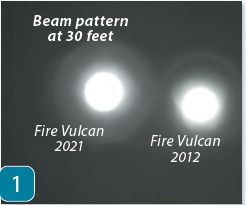
1. The new Fire Vulcan does an even better job of focusing light.

2. The 2012 and 2021 spotlight beam patterns, arranged from lowest to highest luminance.

3. The Tektite at six feet and at 30 feet illustrates its abilities as a spotlight.
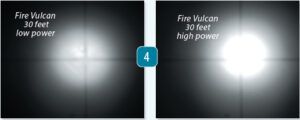
4. The Fire Vulcan had an extremely well-focused beam with little spillover at low and high power.
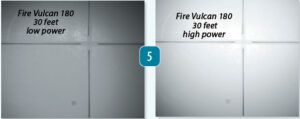
5. Light from the Vulcan 180 was very evenly distributed throughout the central spot.
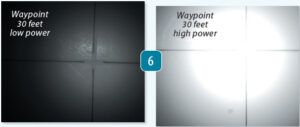
6. The Waypoint’s low-power beam extends the life of the battery, but its power to illuminate dark, non-reflective objects is greatly diminished.

The Streamlight Fire Vulcan 180 offers several noticeable changes over the Vulcan Fire. The most apparent are the pivoting head and the three-LED approach to illumination.

1. The light retains the clothes-iron form factor of the original Fire Vulcan, allowing it to stay put on a flat surface if you set it down. It also affords 180-degree pivoting of the head. For carry, a sturdy web belt with snap fasteners is available.

2. Both 2021 Fire Vulcan 180 and the 2021 Fire Vulcan have rear lights that can be a minor nuisance when trying to preserve night vision. The rear light on the Vulcan 180 can be turned off and is considerably less bright.
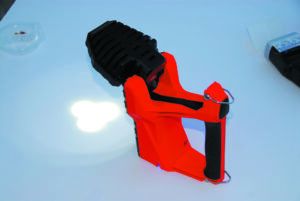
3. The pivoting head can serve as a stationary work lamp. With creative use of bungee cords, Velcro, or straps, it could serve as a backup light for a workbench light, or hands-free spot illumination for dinghy boarding, etc.

Designed to float, the lightweight and easy-to-grip Waypoint is made specifically for the boating market. Its battery life is shorter than the Fire Vulcan, but in terms of illumination, the newer model is much more powerful than its predecessor.
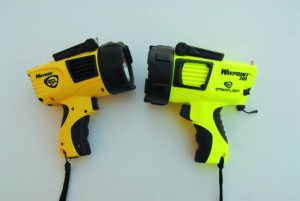
1. The power-level control has been moved from side to rear position for an improvement in usability, but the control positions should have been reversed so “high” is at the top and “low” at the bottom, to provide a more intuitive mapping of the power settings.
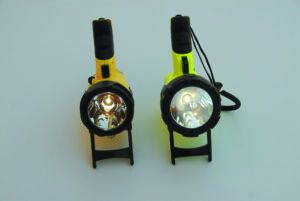
2. The much more powerful LED in the 2021 Waypoint 300 is apparent in this side-by-side image. Not only is the beam more powerful, it is also better focused.
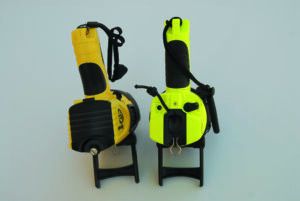
3. An extendable stand offers handsfree lighting at a wide range of angles, but the unit should be tied, velcroed, or shock-corded in place for security. The lanyard is an essential accessory for onboard use.

Designed for divers, the Tektite flashlight is not nearly as brilliant as others in the test, but its adjustable beam ensures it could serve as a spot in a pinch. Best of all, these rugged lights can take a beating.
The beam can be focused manually by rotating the cap, which is also used to turn it on and off. This is a handy light to keep in the cockpit cubby of a small boat, when you don’t want the spotlight exposed to sunlight, getting soaked or bouncing around. The light uses AA alkaline and lithium batteries. These can be disposable or rechargeable (with their own charging station supplied separately). The newer model proved much brighter than its counterpoint , but was nearly identical in all the other features.



































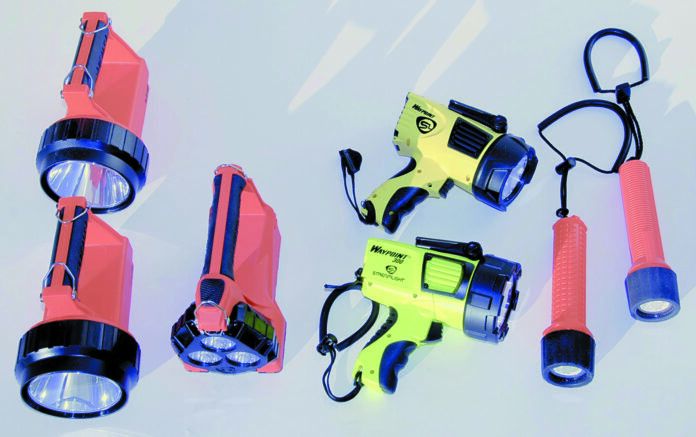






Question: to be clear, all of these may be operated from vessel power only? Example: I need a light that will operate continuously (w/dead battery) when connected to vessel power 12VDC.